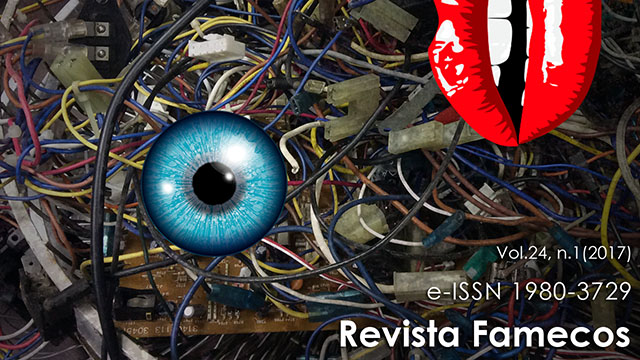The dissident communication and speech by the deeds
DOI:
https://doi.org/10.15448/1980-3729.2017.1.23589Keywords:
Dissident communication, Speech by deeds, DiscourseAbstract
This study elaborated on a special case of communication, used by social actors to convey their dissident messages through dramatic reenactments. Cases are examined and compared. The dissident communication is a special kind of persuasive speech. It aims to affect the climate of public opinion through the right kind of scenes, which allow framing the human emotions that express rebelliousness and criticism. They also allow sending to a specific target audience an implicit political message. The meaning is inferred from the gestures that are interconnected in the dramatization of scenes set in the same way that an interpreter understands a phrase from the play of words in the context of a sentence.Downloads
References
AUSTIN, John. How to do things with words. Cambridge: Harvard University. 1975.
BOORSTIN, Daniel. The Image: A Guide to Pseudo-Events in America. Vintage. 1992.
BURKE, Kenneth. A Grammar of Motives. Berkeley: Universidade da California, 1969.
CANETTI, Elias. Massa e Poder. São Paulo: Cia das Letras, 1995.
FREUD, S. A Psicologia das Massas e Análise do Eu. Porto Alegre: L&PM Editores, 2013.
GASSET, José Ortega. A Rebelião das Massas. Rio de Janeiro: Livro Ibero-Americano, 1971.
GENDRON, Renée. ‘The Meanings of Silence during Conflict.’ Journal of Conflictology, v. 2, n. 1, 2011.
GOFFMAN, Erving. A Representação do Eu na Vida Cotidiana. Rio de Janeiro: Vozes, 1989.
GRICE, H. Paul. Logic and Conversation. In: Syntax and Semantics. New York, v. 3, p. 41-58, 1975. Disponível em: http://www.sfu.ca/~jeffpell/Cogs300/GriceLogicConvers75.pdf
Acesso em: 3 mar. 2016.
JAKOVLJEVIC, Michel B.Shatterede Back Wall: Perfomative Utterance ofa Doll’s Hous. Theatre Journal 54(3): 431-48, 2002.
KAHNEMAN, Daniel. Thinking, Fast and Slow. Londres: Penguin Books. 2012 .
LE BON, Gustave. Psicologia das multidões. São Paulo: WMF Martins Flores, 1895.
LEECH, Geoffrey. Principles of Pragmatics. London: Longman, 1983.
MADONIK, Barbara. I hear what you say, but what are you telling me? The strategic use of nonverbal communication in mediation. São Francisco, CA: Jossey-Bass, 2001.
MANN, Douglas. A Survey of Modern Social Theory. Canada: Oxford University Press, 2008.
MARTIN, Brian. Varieties of dissent. In Stephen P. Banks. Dissent and the Failure of leadership. Cheltenham: Edward Elgar, p. 22-36, 2008.
PAIL, Daisy Batista. A retórica da polidez e dos palavrões nas redes sociais: uma abordagem por interfaces. Porto Alegre: ediPUCRS, 2011.
PINKER, Steve. Do que é feito o pensamento: a língua como janela para a natureza humana. São Paulo: Cia das Letras, 2008.
PINTO, Paulo Roberto Margutti. Iniciação ao Silêncio. São Paulo: Edições Loyola. 1998.
ROSE, Flemming. Why I Published Those Cartoons. Washington Post. 19/02/2006.
______. The Tyranny of Silence. Maryland: NATL Book Network. 2014.
SANI, Fabio e TODMAN, John. Should we stay or should we GO? A social psychological model of schisms in groups. Personality and Social Psychology Bulletin. Califórinia, v. 28, n. 12, p. 1647-1655, 2002.
SARTORI, Roberta. O mundo dos implícitos no debate político-jurídico da eleição presidencial norte-americana de 2000 através do discurso jornalístico: uma abordagem pragmático-lógico-cognitiva da inferência na interface com a comunicação. 2014. Tese (Doutorado em Letras) – Faculdade de Letras, PUCRS, Porto Alegre, 2014.
SHARP, Gene. Poder, Luta e Defesa. Porto Alegre: Paulinas, 1983.
______. Social Power and Political Freedom. Extending Horizon Books, 1980.
STREETER, Thomas. Policy, Politcs, and Discourse. Commnication, Culture & Critique. New Jersey, v. 6, n. 4, p. 488-501, 2013.
THOMAS, William. The Definition of the Situation. In: Self, Symbols, and Society: Classic Readings in Social Psychology, Lanham, MD: Rowman & Littlefield, p.103-115, 2002.
______. The behavior pattern and the situation. Papers and proceedings of the Twenty-Second Annual Meeting of the American Sociological Society, v. 22, 1928.
THOREAU, Henry David. Desobediência Civil. Porto Alegre: L&PM, 1999.
TROTTER, Wilfred. Instincts of the Herd in Peace and War. Nova York: FQ Legacy Books, 2010.
WATTS, Richard. Politeness. Cambridge: CUP, 2003.
WEHNER, Leslie; THIES, Cameron G. Role theory, narratives, and interpretation: the domestic contestation of roles. International Studies Review, v.16, n.3, p. 411- 436. 2014.
WITTEGENSTEIN, Ludwig. Investigações Filosóficas. São Paulo: Abril Cultural,1975.
Published
How to Cite
Issue
Section
License
Copyright
The submission of originals to Revista Famecos implies the transfer by the authors of the right for publication. Authors retain copyright and grant the journal right of first publication. If the authors wish to include the same data into another publication, they must cite Revista Famecos as the site of original publication.
Creative Commons License
Except where otherwise specified, material published in this journal is licensed under a Creative Commons Attribution 4.0 International license, which allows unrestricted use, distribution and reproduction in any medium, provided the original publication is correctly cited.






